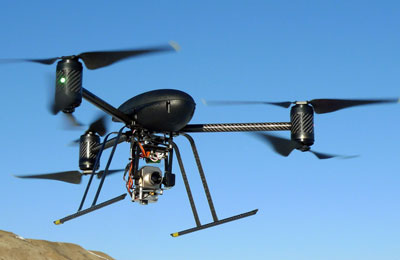
Drones help reshape crime-fighting
New York, March 4, 2013
By Chris Francescani
As US authorities grapple with how to regulate the use of unarmed drones in US skies, a small network of police, first responders and experts is already flying unmanned aircraft.
These operators say rapidly evolving drone technology is already reshaping disaster response, crime scene reconstruction, crisis management and tactical operations.
Critics of US domestic drone use worry about privacy and safety.
Several dozen local police departments, federal agencies and universities have special FAA permits to fly drones in US airspace.
"Like a lot of law enforcement agencies, our first thoughts were, 'Cool! Let's use it for tactical missions - for chasing bad guys across the county,'" said Ben Miller, a Mesa County, Colorado, sheriff's deputy.
"But the reality is you'll have a mission like that once or twice a year," he said. "The real utility of unmanned aerial systems is not the sexy stuff. It's the crime scene and accident reconstruction."
Miller's department in rural western Colorado has the widest approval to fly drones of any local law enforcement agency in the US.
Mesa has flown 40 missions in just over three years, "none of them surveillance," said Miller, who crafted the department's drone program and spent a year devising training protocol for fellow deputies before receiving FAA approval.
"We can now bring the crime scene right into the jury box, and literally re-enact the crime for jurors," he said.
Miller can program the department's GPS-enabled, 3.5-pound DraganflyerX6 quad copter to fly two concentric circles, at two elevations, capturing about 70 photos, for about $25 an hour. He then feeds those images into online digital mapping software, which creates a virtual crime scene that he uploads to his iPad.
Holding the iPad with one hand, Miller recently demonstrated for Reuters how 3-D digital reconstruction can serve as a road map for investigators, and, soon, for juries.
Miller said the same technique can often eliminate the need to shut down highways after accidents so investigators can take accurate measurements.
"For most small law enforcement agencies like ours, the revolution is not in the equipment, but in the cost," he said.
Recent applications to the FAA, obtained by the civil liberties group Electronic Freedom Foundation, indicate many police want drones for drug investigations, covert surveillance and high-risk tactical operations.
Domestic drones currently cost anywhere from $10,000 to $20,000 for a small system like the DraganflyerX6, which stays aloft only 15 minutes, to more than $1 million for sophisticated fixed-wing drones that can remain aloft for hours.
Military models are also being used by the Department of Homeland Security, which has a fleet of at least 10 unarmed Predator drones, powerful enough to identify a tennis shoe from 60,000 feet up.
First-generation drones can't yet carry an onboard sense-and-avoid system, a requirement of manned aircraft. Experts said mass-produced, drone-mounted sense-and-avoid technology is still two to five years away.
FAA officials are required to open US skies in 2015 to widespread use of unmanned aircraft by public agencies and private industry.
PRESSING THE BOUNDARIES
Texas pilot Gene Robinson has been designing and flying domestic drone systems custom-made for disaster and emergency response for more than a decade.
Robinson said his drone has flown dozens of search missions for law enforcement agencies in 29 states and four countries, locating 10 missing persons after traditional search-and-rescue resources were exhausted.
When the FAA formally banned commercial drone use in the US in 2007, Robinson registered his company as a 501(c)3 non-profit to sidestep the ban on commercial drone use.
"That drives the FAA nuts," Miller said.
As far as Robinson is concerned, the feeling is mutual.
FAA officials continued to deny his requests for emergency approval, Robinson said.
He reached a breaking point with the FAA in 2010, in a field outside Dallas, Texas. Standing beside the frantic father of a missing 7-year-old, Robinson received a call from an FAA official who, he said, denied his request to use his drone to search for the child.
He refused to relay the information to the father. "I'm not going to tell the father," he said he told the official. "You are."
He handed the phone to the father and was "lucky to get that phone back in one piece."
Weeks later, Robinson said, local authorities who had sought his assistance located the child's body.
Robinson said he no longer seeks FAA permission for emergency response. After that incident, "I decided it was going to be easier to ask forgiveness than permission." - Reuters







